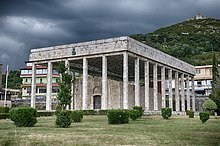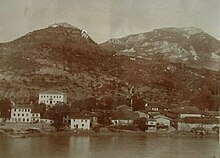Skanderbeg memorial
The Skanderbeg Memorial ( Albanian Mauzoleu i Skënderbeut ), formerly St. Nicholas Church ( Kisha e Shën Kollit ) or Selimiye Mosque ( Alb.Xhamia Selimije ) is a church in the northern Albanian city of Lezha that was converted into a mosque by the Ottomans . Its ruins were built over and converted into a memorial to the Albanian prince and Turkish fighter Skanderbeg (1405–1468).
On the site of a previous building from the 14th century, the St. Nicholas Church was built in 1459 as the Lezha Cathedral . It is located below the castle hill not far from the Drin . The building measures about 18 by 8 meters. The single-nave Gothic building had an apse in the east , three small windows each in the north and south, and another round window above the door on the west facade.
Skanderbeg was buried in 1468 in St. Nicholas Church , Lezha's main church. In 1478, after the conquest of Lezha by Sultan Mehmed II , the grave was desecrated by Ottoman soldiers and Skanderbeg's bones were used by them as talismans . Under Sultan Selim I (1512–1520) the church was converted into a mosque. It was named after the Sultan Selimiye Mosque . Crumbled into ruins in the 17th century, Albanians made pilgrimages here to hold memorial services for Skanderbeg.
The art historian Machiel Kiel, however, writes the mosque to the Sultan Selim III. (1762-1808) to. The building was used by Christians until the late 16th century and was only converted into a mosque in the 1580s, when a Muslim quarter was built in the lower town. By 1630 the mosque had already collapsed. It was not until the end of the 18th century under Selim III. restored or even rebuilt. The mosque had a mihrāb and a high minaret in the southwest , which was built in the 18th century.
In 1966 the mosque was archaeologically examined, which allowed the conclusion that it must have been the St. Niklaus Church earlier. The mosque served as a Muslim place of prayer until 1968. When the Communist dictator Enver Hoxha proclaimed the “first atheist state in the world” in 1967, the Socialist People's Republic of Albania was closed.
In 1978, Skanderbeg's grave was discovered in the mosque. In 1979, an earthquake shook the region. The minaret collapsed and the mosque was badly damaged. As a result, all Ottoman additions to the former church were removed in order to bring the appearance as close as possible to the times of Skanderbeg, and the ruins were converted into a memorial to the national hero. The ruins of the Niklaus Church have been declared a national cultural monument.
In 1981 the new Skanderbeg memorial was opened. A large roof structure protects the old walls, in which a bust of Odhise Paskali and a memorial plaque with a replica of Skanderbeg's sword and helmet - the originals are in Vienna - were placed. On the wall are signs commemorating the battles of Skanderbeg and the coats of arms of the principalities of the League of Lezha . In 2018 the roof structure was restored. For the first time in decades, a forgotten crypt or grave tomb was opened under the building.
Around the mosque ruins there are still some ruins from ancient times. The wide complex on the east bank of the Drin, which has been freed from other buildings, is north of downtown Lezha. It is to be expanded into an archeology park. During further excavations, the port gate on the banks of the Drin, a temple converted into a Christian church and a baptistery were found.
literature
- Feride Papleka (Ed.): Georg Kastrioti grave memorial - Skanderbegs . 8 Nëntori, Tirana 1987.
Web links
Individual evidence
- ↑ Zani i Naltë. Muslim Community of Albania , p. 2 , accessed October 10, 2015 .
- ↑ a b c d Guntram Koch: DuMont art travel guide Albania . DuMont, Cologne 1989, ISBN 3-7701-2079-5 , p. 143 f .
- ^ A b c d Machiel Kiel: Ottoman architecture in Albania (1385–1912) . In: Research Center for Islamic History, Art and Culture (Ed.): Islamic art series . tape 5 . Istanbul 1990, ISBN 92-9063-330-1 , Selimiye Mosque, p. 193 .
- ↑ Oliver Jens Schmitt : Skanderbeg - the new Alexander in the Balkans. Pustet, Regensburg 2009, ISBN 978-3-7917-2229-0 , pp. 290 .
- ↑ a b c Feride Papleka (ed.): Georg Kastrioti grave memorial - Skanderbegs . 8 Nëntori, Tirana 1987.
- ↑ Machiel Kiel, Bashkim Lahi: Cathedral of St. Nicholas / Mosque Selimiye / Skanderbeg grave and memorial monumnet . In: Christian Zindel, Andreas Lippert, Bashkim Lahi, Machiel Kiel (eds.): Albania: an archeology and art guide from the Stone Age to the 19th century . Böhlau, Vienna 2018, ISBN 978-3-205-20723-8 , pp. 518 .
- ^ Objects Fetare Monument Kulture. In: Komiteti Shtetëror për Kultet. Retrieved October 17, 2015 (Albanian).
- ↑ ABC News Albania: Hapet kapaku mister ne vendvarrimin e Skenderbeut on YouTube , accessed on August 6, 2018.
- ^ Volker Grundmann: Travel Guide Albania . Unterwegs Verlag, Singen 2013, ISBN 978-3-86112-293-7 , p. 25 .
Coordinates: 41 ° 46 ′ 57 ″ N , 19 ° 38 ′ 35 ″ E


